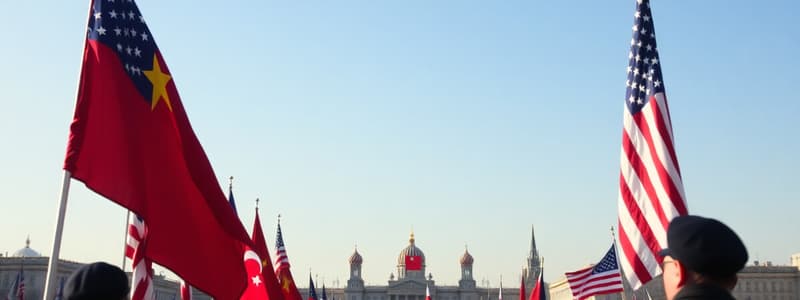Podcast
Questions and Answers
शीत युद्ध के दौरान किस विचारधारा ने अमेरिका का प्रतिनिधित्व किया?
शीत युद्ध के दौरान किस विचारधारा ने अमेरिका का प्रतिनिधित्व किया?
- लोकतांत्रिक पूंजीवाद (correct)
- अराजकता
- कम्युनिज़्म
- समाजवाद
नाटो (NATO) और वरसोवा संधि का उद्देश्य क्या था?
नाटो (NATO) और वरसोवा संधि का उद्देश्य क्या था?
- एकजुट राजनीतिक दलों का गठन
- विरुद्धपक्षों की सैन्य गठबंधन (correct)
- समानता के प्रावधान करना
- आर्थिक सहयोग की स्थापना
क्यूबा मिसाइल संकट किस वर्ष हुआ?
क्यूबा मिसाइल संकट किस वर्ष हुआ?
- 1962 (correct)
- 1964
- 1961
- 1963
साल्ट I और साल्ट II क्या थे?
साल्ट I और साल्ट II क्या थे?
शीत युद्ध में किस संघर्ष को द्वेष के तहत प्रतिनिधित्व किया गया?
शीत युद्ध में किस संघर्ष को द्वेष के तहत प्रतिनिधित्व किया गया?
शीत युद्ध के अंत के प्रतीक के रूप में क्या महत्वपूर्ण घटना हुई?
शीत युद्ध के अंत के प्रतीक के रूप में क्या महत्वपूर्ण घटना हुई?
शीत युद्ध के दौरान विज्ञान के क्षेत्र में प्रतिस्पर्धा का मुख्य उदाहरण क्या था?
शीत युद्ध के दौरान विज्ञान के क्षेत्र में प्रतिस्पर्धा का मुख्य उदाहरण क्या था?
सोवियत संघ के पतन का मुख्य कारण कौन सा था?
सोवियत संघ के पतन का मुख्य कारण कौन सा था?
Flashcards
Cold War
Cold War
A period of geopolitical tension between the Soviet Union and the United States, roughly from 1947 to 1991.
Superpowers
Superpowers
The dominant global powers in the Cold War; the United States and the Soviet Union.
Ideological Conflict
Ideological Conflict
The Cold War's core struggle between opposing political philosophies: democratic capitalism and communism.
Proxy Wars
Proxy Wars
Signup and view all the flashcards
Berlin Wall
Berlin Wall
Signup and view all the flashcards
NATO
NATO
Signup and view all the flashcards
Cuban Missile Crisis
Cuban Missile Crisis
Signup and view all the flashcards
Soviet Collapse
Soviet Collapse
Signup and view all the flashcards
Study Notes
Origins and Context
- The Cold War was a period of geopolitical tension between the Soviet Union and the United States and their respective allies.
- It followed World War II and lasted from roughly 1947 to 1991.
- Key factors contributing to the conflict included ideological differences (communism vs. capitalism), differing post-war agendas, and the fear of nuclear annihilation.
- Post-war tensions quickly escalated due to disagreements over the future of Eastern Europe and other regions.
Key Players and Alliances
- The two superpowers were the United States and the Soviet Union.
- The United States led a group of Western democracies, including Great Britain, France, and later West Germany.
- The Soviet Union controlled communist regimes in Eastern Europe, including countries like Poland, Czechoslovakia, and Hungary.
- The formation of NATO (North Atlantic Treaty Organization) and the Warsaw Pact were key military alliances that solidified the division into opposing blocs.
Key Events and Conflicts
- The Berlin Blockade (1948-1949) and the subsequent Berlin Airlift were early confrontations.
- The Korean War (1950-1953) showcased the proxy conflicts fought between the two sides.
- The Cuban Missile Crisis (1962) was perhaps the closest the world came to nuclear war.
- The Vietnam War (1955-1975), another proxy war, significantly impacted US politics and society.
- The Soviet invasion of Afghanistan (1979) heightened tensions and strained relations.
Ideological Struggles
- The Cold War was fundamentally based on opposing ideologies.
- The United States represented democratic capitalism, while the Soviet Union advocated for communism.
- Propaganda and ideological warfare were significant features of the conflict.
- Competition in scientific fields, such as space exploration, served as a major area of ideological contest.
Detente and Escalation
- Periods of relaxation in tensions, known as détente, occurred in the 1970s.
- Arms control agreements, like SALT I and SALT II, were signs of reduced hostilities.
- However, the Cold War was characterized by an ongoing arms race, leading to a buildup of nuclear weapons on both sides.
Dissolution of the Soviet Union
- Economic stagnation and internal pressures within the Soviet Union eventually led to its collapse.
- The fall of the Berlin Wall (1989) symbolized the end of the division of Europe.
- The dissolution of the Soviet Union in 1991 marked the end of the Cold War.
Lasting Effects
- The Cold War fundamentally reshaped the global political landscape.
- The emergence of new nations influenced by Cold War politics continues to be seen today.
- The legacy of the Cold War continues to be studied and debated, influencing international relations and security concerns.
- The influence of the two superpowers is seen in modern politics and global affairs.
Studying That Suits You
Use AI to generate personalized quizzes and flashcards to suit your learning preferences.



